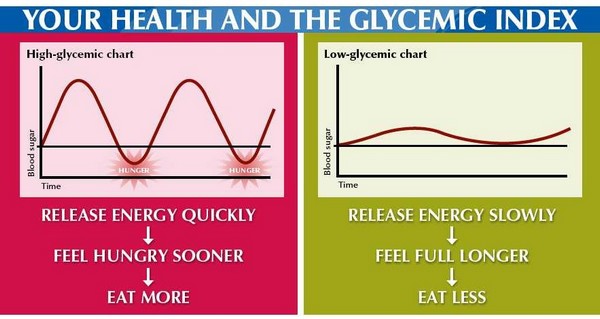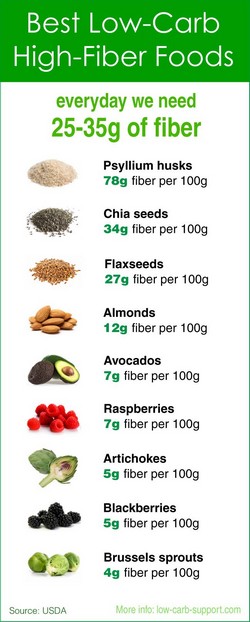

Excerpts from the Harward School of Public Health and other contributors
We can build our health with food if we eat a balanced "live" diet . Our body needs Carbohydrates, Proteins and Fats.
Carbohydrates are made of carbon, hydrogen and oxygen.
There are three general classes of carbohydrates:
1) sugars
2) starches
3) "unavailable" carbohydrates, which are fiber needed in our intestinal system (fruit, vegetables, grains)
The most common and abundant carbohydrates are sugars, starches and fibers. The basic building blocks of a carbohydrate are sugar molecules. Starches and fibers are essentially chains of sugar molecules. Some contain hundreds of sugars. Some chains are straight, others branch wildly.

|
|
2. Complex carbohydrates
(better for us all!)
Complex carbohydrates include everything made of three or more linked sugars. Simple sugars were considered bad and complex carbohydrates good, but the picture is much more complicated than that.
Complex carbohydrate foods are basically those in wholegrain form such as wholegrain breads, oats, muesli and brown rice. Complex carbs are broken down into glucose more slowly than simple carbohydrates and thus provide a gradual steady stream of energy throughout the day.
Complex carbohydrates should be a major component of your diet; about half of your daily calories should come from carbohydrates - mostly from grains, cereals, fruits and vegetables. Only a few of your daily calories should come from simple carbohydrates, usually known as sugars.
Examples of foods containing complex carbohydrates
|
|
|
The digestive system handles all carbohydrates in much the same way - it breaks them down into single sugar molecules, since only these are small enough to be absorbed into the bloodstream. It converts most digestible carbohydrates into glucose, because cells are designed to use this glucose as our energy source through the Kreb's cycle. In the Kreb's cycle, cells function through mitochondria, which produce ATP (adenosine triphosphate), our source of energy.
Fiber is an exception. It is an "unavailable" carbohydrate because our body cannot digest it. It consists of cellulose from the vegetables, fruit, beans and grain. These carbohydrates are important because they pass through the body and make the bulk that keep the bowels in good working condition.
Carbohydrates and the Glycemic Index
 The glycemic index, measures how fast and how far blood sugar rises after we eat a food that contains carbohydrates. White bread, for example, is digested almost immediately to glucose, causing blood sugar to spike rapidly. So white bread is classified as having a high glycemic index. Brown rice, in contrast, is digested more slowly, causing a lower and more gentle change in blood sugar. It has a lower glycemic index.
The glycemic index, measures how fast and how far blood sugar rises after we eat a food that contains carbohydrates. White bread, for example, is digested almost immediately to glucose, causing blood sugar to spike rapidly. So white bread is classified as having a high glycemic index. Brown rice, in contrast, is digested more slowly, causing a lower and more gentle change in blood sugar. It has a lower glycemic index.
The most comprehensive list of the glycemic index of foods was published in the July, 2002, issue of the American Journal of Clinical Nutrition. A searchable database maintained by the University of Sydney is available online (on that excellent site, click on GI Database - left column).
Diets filled with high-glycemic-index foods, which cause quick and strong increases in blood sugar levels, have been linked to an increased risk for both diabetes and heart disease. On the other hand, lower GI foods have been shown to help control type 2 diabetes.
One of the most important factors that determine a food's glycemic index is how highly processed its carbohydrates are. Processing carbohydrates removes the fiber-rich outer bran and the vitamin- and mineral-rich inner germ. What's left is mostly the starchy endosperm. Other factors that influence how quickly the carbohydrates in food raise blood sugar include:
Fiber content (fiber adds bulk to your fecal material, which hastens its passage through your gut and prevents that constipated feeling.)
Fiber shields the starchy carbohydrates in food immediate and rapid attack by digestive enzymes. This slows the release of sugar molecules into the bloodstream.
Ripeness
Ripe fruits and vegetables tend to have more sugar than unripe ones, and so tend to have a higher glycemic index.
Type of starch
Starch comes in many different configurations. Some are easier to break into sugar molecules than others. The starch in potatoes, for example, is digested and absorbed into the bloodstream relatively quickly.
Fat content and acid content
The more fat or acid a food contains, the slower its carbohydrates are converted to sugar and absorbed into the bloodstream. Nuts are beneficial sources of low GI carbohydrates.
Physical form
Finely ground grain is more rapidly digested, and so has a higher glycemic index, than more coarsely ground grain.
These combine to create sometimes counterintuitive results. Some foods that contain complex carbohydrates, such as potatoes, quickly raise blood sugar levels, while some foods that contain simple carbohydrates, such as whole fruit, raise blood sugar levels more slowly. Although the fine points of the glycemic index may seem complicated, the basic message is simple: Whenever possible, replace highly processed grains, cereals, and sugars with minimally processed whole-grain products. And only eat potatoes - once on the list of preferred complex carbohydrates - occasionally because of their high glycemic index.
When Sugar Management Goes Awry
Digestible carbohydrates are broken down in the intestine into their simplest form, sugar, which then enters the blood. As blood sugar levels rise, special cells in the pancreas churn out more and more insulin, a hormone that signals cells to absorb blood sugar for energy or storage. As cells sponge up blood sugar, its levels in the bloodstream fall back to a preset minimum. So do insulin levels.
In some people, this cycle doesn't work properly. People with type 1 diabetes (once called insulin-dependent or juvenile diabetes) do not make enough insulin, so their cells cannot absorb sugar.
People with type 2 diabetes (once called non-insulin dependent or adult onset diabetes) usually start out with a different problem - their cells do not respond well to insulin's "open up for sugar" signal. This condition, known as insulin resistance, causes both blood sugar and insulin levels to stay high long after eating. Over time, the heavy demands made on the insulin-making cells wears them out, and insulin production slows, then stops.
Insulin resistance is not just a blood sugar problem. It has also been linked with a variety of other problems, including high blood pressure, high levels of triglycerides, low HDL (good) cholesterol, heart disease, and possibly some cancers.
Genes, a sedentary lifestyle, being overweight, and eating a diet filled with foods that cause big spikes in blood sugar can all promote insulin resistance. Data from the Insulin Resistance Atherosclerosis Study suggests that cutting back on refined grains and eating more whole grains in their place can improve insulin sensitivity.
Note from Four Winds Nutrition
If you have a blood sugar issue try anyone of these 2 formulas and add GTF Chromium.
|
|
|
No Carbohydrates?
Some popular diets, particularly the Atkins diet, treat carbohydrates as if they are evil, the root of all body fat and excess weight. While there is some evidence that a low-carbohydrate diet may help people lose weight more quickly than a low-fat diet, no one knows the long-term effects of eating little or no carbohydrates. Equally worrisome is the inclusion of unhealthy fats in some of these diets.
If you want to go the lower carb route, try to include some fruits, vegetables, root vegetables, nuts and whole-grain carbohydrates every day. They contain a host of vitamins, minerals, and other phytonutrients that are essential for good health.
|